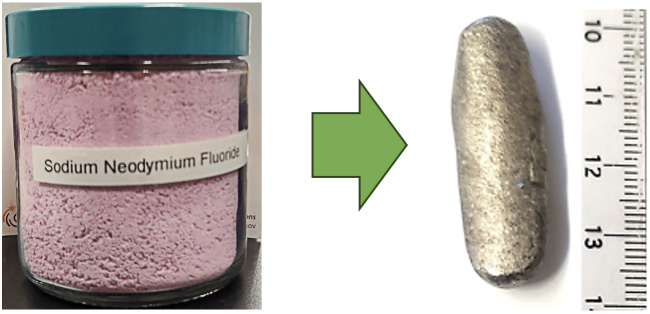There are 17 elements that make up the materials called rare earth elements. Each of these can be used to make rare earth metals. While some metals like gold, silver, copper and platinum, are mined in their metallic forms, others, including iron, aluminum, and lead are found in mineral ores and must be chemically processed to extract and refine the pure metals. Much like these latter metals, when rare earth elements come out of a mine, they are bound with other elements in complex mineral mixtures and must be converted into a metallic form. These metals can then be used in a variety of technologies.
The U.S. Department of Energy’s Ames National Laboratory has been a leader in producing rare earth metals for more than 75 years. An important part of this history is built on Harley Wilhelm’s invention of the Ames Process. The Ames Process was originally developed to produce high-purity uranium to support the Manhattan Project. It remains an important and effective method for producing high-purity rare earth metals today.

A team of Ames Lab researchers at the Critical Materials Innovation Hub has developed a new, safer, scalable method for producing rare earth metals that utilizes the Ames Process. This new method, Rare Earth Metals from Alternative Fluoride Salt (REMAFS), uses an alternative fluoride salt in the production of rare earth metals, instead of the traditional rare earth salts that are made with harmful hydrofluoric acid (HF). Additionally, the method can be integrated earlier in the rare earth supply chain to reduce the number of steps required to convert mined materials to rare earth metals.
Ikenna Nlebedim, the deputy director of the Division of Critical Materials and a scientist at Ames Lab who led the research group, explained that by eliminating both the use and generation of HF, REMAFS significantly improves safety, environmental impacts, and scalability.
“This process uses rare earth fluoride, but instead of traditional rare earth fluoride, it uses sodium rare earth fluoride. The difference is that sodium rare earth fluoride can be prepared without hydrofluoric acid,” Nlebedim said. “It can be prepared at room temperature, and it is very easy to scale, so you can produce large quantities of it.”
Scalability is often a challenge for researchers developing new materials and processes. It can be challenging to move from an amount processed in the lab to a much larger amount that would be necessary for use in industry applications.
“The ability to easily produce large quantities of materials for the REMAFS process is a key step toward commercial deployment,” explained Denis Prodius, the project lead and a scientist at Ames Lab. “Discussions around large-scale implementation are already underway with the licensee.”
In addition to being easy to prepare and scale-up to large quantities, the method can reduce the number of steps required to process rare earth elements before they can be transformed into metal. Trevor Riedemann, a research technologist at Ames Lab who is part of the research team, joined Nlebedim in explaining the details.
Rare earth elements are found in certain types of rocks, along with a mixture of other elements. These rocks are mined, crushed, and chemicals are added to concentrate the rare earth elements. At this stage, they are still in a mixture, like a chemical soup. Next, they go through a special process to separate them into their individual rare earth salts, which are subsequently turned into oxides. For the Ames process, before the rare earths can be turned into metals, the oxides are changed into their fluorides – another type of salt.
“You start with salt, convert it to an oxide, turn it again to a salt before you reduce the salt to metal,” Riedemann explained. “For the REMAFS process, we're going from salt to metal and cutting out having to fully convert to the oxide and then go back to salt. If you can start at the salt and eliminate the oxide process completely, you'd be saving money.”
Nlebedim emphasized that their new method can start with materials either from the first salt stage, or with oxides.
“So another unique thing about this process is that this feedstock is easier to make than the traditional feedstock, which eliminates the hazards associated with making those feedstocks,” said Nlebedim. “Anytime you could avoid working with nasty chemicals, such as HF, it is something that is very good for everybody.”
The Critical Materials Innovation (CMI) Hub is an Energy Innovation Hub led by the U.S. Department of Energy’s Ames National Laboratory with support from the Office of Energy Efficiency and Renewable Energy’s Advanced Materials and Manufacturing Technologies Office (AMMTO). CMI seeks ways to accelerate the development of critical material technologies and enhance the innovation pipeline for U.S. supply chains by accelerating research, educating a diverse workforce, and creating de-risked, commercial-ready technologies in partnership with American industry.
Ames National Laboratory is a U.S. Department of Energy Office of Science National Laboratory operated by Iowa State University. Ames Laboratory creates innovative materials, technologies, and energy solutions. We use our expertise, unique capabilities, and interdisciplinary collaborations to solve global problems.
Ames National Laboratory is supported by the Office of Science of the U.S. Department of Energy. The Office of Science is the single largest supporter of basic research in the physical sciences in the United States and is working to address some of the most pressing challenges of our time. For more information, please visit https://energy.gov/science.
